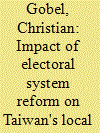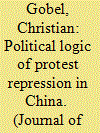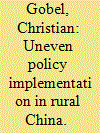| Srl | Item |
| 1 |
ID:
114785


|
|
|
|
|
| Publication |
2012.
|
| Summary/Abstract |
This article discusses specific impacts of the abolishment of the single non-transferable vote (SNTV) in Taiwan. The SNTV had long been seen as a major factor in the sustenance of county- and township-level clientelist networks. It was associated with extremism, candidate-centered politics, vote-buying, clientelism and organized crime involvement in politics. This article examines the impact of the electoral reform on the mobilization capacity of a local faction in a rural county notorious for its factionalism. The analysis indicates that the clientelist structures are too resilient to be affected by even a radical electoral reform.
|
|
|
|
|
|
|
|
|
|
|
|
|
|
|
|
| 2 |
ID:
132732


|
|
|
|
|
| Publication |
2014.
|
| Summary/Abstract |
Field research in China often requires the researcher to cooperate with two kinds of actors: research collaborators, such as those at universities or official think tanks, and local officials. These actors facilitate or enhance field access, but such access comes at the price of a potential "pre-selection bias" in data collection. Some scholars have argued that dependence on these "gatekeepers" introduces a significant bias into research outcomes. I argue, however, that the constraints faced by China scholars in their field studies are not absolute, but function by degree. The CCP is monolithic neither in its organization nor in the thoughts of its agents, and close collaboration with local partners can help remove normative bias rather than necessarily introducing it. Most importantly, an argument built exclusively on the power of structural constraints discounts China scholars' most crucial abilities: to learn, to think critically and to research holistically.
|
|
|
|
|
|
|
|
|
|
|
|
|
|
|
|
| 3 |
ID:
178758


|
|
|
|
|
| Summary/Abstract |
Why do China’s authorities repress some protests, but not others? By how much do crowd size, violent tactics and protest location increase the likelihood of repression? Based on a newly available dataset of more than 70,000 protest events collected from social media, this article tests three competing explanations of protest repression in China. It finds that repression is closely correlated both with the cost of concessions for local governments and protest intensity. A small-scale and peaceful labor protest in an urban locality very seldom encounters repression, but rural riots against land grabs, evictions or environmental pollution are nearly certain to experience state-sanctioned violence or arrests even if the number of participants is low.
|
|
|
|
|
|
|
|
|
|
|
|
|
|
|
|
| 4 |
ID:
102109


|
|
|